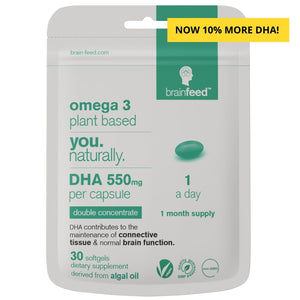DHA benefit of breastfed “omega 3 milk”: how omega 3 is good for breastfed babies
filter
The early stages of life lay the foundation for lifelong health and well-being. Breastfeeding, a natural practice, provides infants with a powerhouse of nutrients critical for their growth and development. Among these nutrients, omega 3’s DHA or Docosahexaenoic acid emerges as a standout player. DHA benefit for breastfed babies has garnered significant attention from the scientific community. In this article, compelling evidence that underscores the benefits of DHA while breastfeeding is presented, explaining how this essential fatty acid supports cognitive function.
DHA: brain’s best friend
DHA is pivotal in various bodily functions, particularly in the brain and visual development. When incorporated into the diet of breastfeeding mothers, the benefits of docosahexaenoic acid or DHA during breastfeeding are supported by the European Food Safety Authority (EFSA) which states that “maternal intake contributes to the normal brain development and development of the eye of breastfed infants” when 200mg of DHA is obtained through the daily intake while 250mg of omega 3 is ingested in addition[1 Trusted Source 2011 - European Food Safety Authority Journal Research evaluation Scientific Opinion on the substantiation of health claims related to docosahexaenoic acid (DHA), eicosapentaenoic acid (EPA) and brain, eye and nerve development (ID 501, 513, 540), maintenance of normal brain function (ID 497, 501, 510, 513, 519, 521, 534, 540, 688, 1323, 1360, 4294), maintenance of normal vision (ID 508, 510, 513, 519, 529, 540, 688, 2905, 4294), maintenance of normal cardiac function (ID 510, 688, 1360), “maternal health; pregnancy and nursing” (ID 514), “to fulfil increased omega-3 fatty acids need during pregnancy” (ID 539), “skin and digestive tract epithelial cells maintenance” (ID 525), enhancement of mood (ID 536), “membranes cell structure” (ID 4295), “anti-inflammatory action” (ID 4688) and maintenance of normal blood LDL-cholesterol concentrations (ID 4719) pursuant to Article 13(1) of Regulation (EC) No 1924/2006 ] , [2 Trusted Source 2006 - The American Journal of Clinical Nutrition Research evaluation Distribution, interconversion, and dose response of n−3 fatty acids in humans ] . Scientific opinion differs and scientists recommend a higher dose of 550 mg of DHA daily for healthy adults as study findings show it's the most beneficial[3]. High-dose supplementation of DHA has been shown to maintain the levels throughout the supplementation period, peaking at 18 weeks[2 Trusted Source 2006 - The American Journal of Clinical Nutrition Research evaluation Distribution, interconversion, and dose response of n−3 fatty acids in humans ] , [4 Trusted Source 1994 - Biochimica et Biophysica Acta (BBA) - Lipids and Lipid Metabolism Human study Changes of N-3 and N-6 fatty-acids in plasma and circulating cells of normal subjects, after prolonged administration of 20/5 (EPA) and 22/6 (DHA) ethyl-esters and prolonged washout ] . DHA concentrations return to baseline after supplementation has been stopped[4 Trusted Source 1994 - Biochimica et Biophysica Acta (BBA) - Lipids and Lipid Metabolism Human study Changes of N-3 and N-6 fatty-acids in plasma and circulating cells of normal subjects, after prolonged administration of 20/5 (EPA) and 22/6 (DHA) ethyl-esters and prolonged washout ] . Instead of supplementing with cod liver oil & breastfeeding, NHS suggests eating fish is good for your and your baby's health. The best DHA supplement for breastfeeding is safe and provides you with high-quality supplements to obtain the additional DHA intake. brain feed developed a 550 mg softgel vegan capsule from a sustainable algae source that is a safe DHA supplement for breastfeeding mothers.
Breastfeeding babies with DHA
Breast milk naturally contains DHA, providing breastfed babies with a direct supply of this essential nutrient to support their growing brains[5 Trusted Source 2011 - Maternal & Child Nutrition Systematic and meta-analysis Maternal fatty acid status during pregnancy and lactation and relation to newborn and infant status ] . Multiple studies on lactating mothers showed that a higher amount of DHA in breast milk is linked to the mother’s higher dietary intake of DHA or DHA supplementation[6 Trusted Source 1996 - European Journal of Clinical Nutrition Human study Effect of maternal docosahexaenoic acid (DHA) supplementation on breast milk composition ] , [7 Trusted Source 2017 - International Breastfeeding Journal Human study Breast milk DHA levels may increase after informing women: a community-based cohort study from South Dakota USA ] . Additionally, researchers examined the link between the amount of omega 3 in milk from breastfeeding mothers and mathematics test scores of 15-year-old students in 28 countries in Europe, Asia, and North and South America[8 Trusted Source 2015 - Maternal & Child Nutrition Human study Maternal milk DHA content predicts cognitive performance in a sample of 28 nations ] . This study suggests that a country’s balance of dietary omega 3 fats which is reflected in the amount of DHA in breast milk is strongly related to students’ performance on a standardised mathematics test regardless of national wealth, investment in education and macronutrient diet in a certain country. So, how exactly does DHA for breastfeeding mothers which is found in their breast milk impact breastfeeding babies?
Igniting young minds
The early stages of life are marked by rapid brain growth and neural development. DHA plays an essential role in this process, as it is a critical component of the protective barrier of a brain cell known as a membrane. A literature review led by Dr Lotte Lauritzen, the editorial board member of Maternal and Child Nutrition at the British Journal of Nutrition, highlights the connection between maternal DHA while breastfeeding and infant cognitive development[5 Trusted Source 2011 - Maternal & Child Nutrition Systematic and meta-analysis Maternal fatty acid status during pregnancy and lactation and relation to newborn and infant status ] .
Fueling cognitive potential
Cognitive development in early childhood is a complex and remarkable journey. DHA's role in this journey is evident in a study on 44 infants[9 Trusted Source 1998 - The Lancet Human study Effect of long-chain polyunsaturated fatty acids in infant formula on problem solving at 10 months of age ] . One group of infants were supplemented with DHA formula while the other drank the regular formula from their birth for 4 months. Infants receiving the DHA-enriched formula exhibited improved cognitive outcomes compared to those receiving the standard formula. This suggests that DHA breastfeeding supplementation, whether through breast milk or fortified formula, regardless of DHA sources, positively influences cognitive potential during these formative years.
A fine eye for detail
Visual acuity is another area where DHA shines. The part of the eye that provides your brain with a visual picture called the retina contains a high concentration of DHA. A study researched the effects of different milk formulas on 244 infants[10 Trusted Source 2010 - The American Journal of Clinical Nutrition Human study The DIAMOND (DHA Intake And Measurement Of Neural Development) Study: a double-masked, randomized controlled clinical trial of the maturation of infant visual acuity as a function of the dietary level of docosahexaenoic acid ] . Infants drinking the DHA formula exhibited better visual acuity at 12 months than those who received the normal formula. Maternal breast milk, rich in DHA and omega 3 while breastfeeding, is a natural source of omega 3, good for healthy vision in breastfed babies.
As our understanding of nutrition's impact on early development deepens, the role of DHA becomes even more remarkable. By embracing breastfeeding and supporting the natural presence of DHA in breast milk, parents and caregivers play a pivotal role in nurturing the potential of the next generation. Choose quality and opt for the best omega 3 supplement for breastfeeding.
References
[1] EFSA (2011). Scientific Opinion on the substantiation of health claims related to docosahexaenoic acid (DHA), eicosapentaenoic acid (EPA) and brain, eye and nerve development (ID 501, 513, 540), maintenance of normal brain function (ID 497, 501, 510, 513, 519, 521, 534, 540, 688, 1323, 1360, 4294), maintenance of normal vision (ID 508, 510, 513, 519, 529, 540, 688, 2905, 4294), maintenance of normal cardiac function (ID 510, 688, 1360), “maternal health; pregnancy and nursing” (ID 514), “to fulfil increased omega-3 fatty acids need during pregnancy” (ID 539), “skin and digestive tract epithelial cells maintenance” (ID 525), enhancement of mood (ID 536), “membranes cell structure” (ID 4295), “anti-inflammatory action” (ID 4688) and maintenance of normal blood LDL-cholesterol concentrations (ID 4719) pursuant to Article 13(1) of Regulation (EC) No 1924/2006. EFSA Journal, 9(4), 2078–2108. https://www.efsa.europa.eu/en/efsajournal/pub/2078
[2] Arterburn, L. M., Hall, E. B., & Oken, H. (2006). Distribution, interconversion, and dose response of n−3 fatty acids in humans. The American Journal of Clinical Nutrition, 83(6), 1467S-1476S. https://www.sciencedirect.com/science/article/pii/S0002916523294861?via%3Dihub
[3] Rafati, P., Hameed, M., Huang, X., & Isyaku, K. L. (2020). Review: The effect of DHA supplementation on the human health [Final Report]. University of Salford Manchester.
[4] Marangoni, F., Angeli, M., Colli, S., Eligini, S., Tremoli, E., Sirtori, C., & Galli, C. (1994). Changes of N-3 and N-6 fatty-acids in plasma and circulating cells of normal subjects, after prolonged administration of 20/5 (EPA) and 22/6 (DHA) ethyl-esters and prolonged washout. Biochimica et Biophysica Acta (BBA) - Lipids and Lipid Metabolism, 1210, 55–62. https://www.sciencedirect.com/science/article/abs/pii/000527609390049F?via%3Dihub
[5] Lauritzen, L., & Carlson, S. E. (2011). Maternal fatty acid status during pregnancy and lactation and relation to newborn and infant status. Maternal & Child Nutrition, 7(s2), 41–58. https://onlinelibrary.wiley.com/doi/10.1111/j.1740-8709.2011.00303.x
[6] Makrides, M., Neumann, M. A., & Gibson, R. A. (1996). Effect of maternal docosahexaenoic acid (DHA) supplementation on breast milk composition. European Journal of Clinical Nutrition, 50(6), 352–357. https://europepmc.org/article/med/8793415
[7] Juber, B. A., Jackson, K. H., Johnson, K. B., Harris, W. S., & Baack, M. L. (2017). Breast milk DHA levels may increase after informing women: A community-based cohort study from South Dakota USA. International Breastfeeding Journal, 12(1), Article 7. https://internationalbreastfeedingjournal.biomedcentral.com/articles/10.1186/s13006-016-0099-0
[8] Lassek, W. D., & Gaulin, S. J. C. (2015). Maternal milk DHA content predicts cognitive performance in a sample of 28 nations. Maternal & Child Nutrition, 11(4), 773–779. https://onlinelibrary.wiley.com/doi/10.1111/mcn.12060
[9] Willatts, P., Forsyth, J. S., DiModugno, M. K., Varma, S., & Colvin, M. (1998). Effect of long-chain polyunsaturated fatty acids in infant formula on problem solving at 10 months of age. The Lancet, 352(9129), 688–691. https://www.thelancet.com/journals/lancet/article/PIIS0140-6736(97)11374-5/abstract
[10] Birch, E. E., Carlson, S. E., Hoffman, D. R., Fitzgerald-Gustafson, K. M., Fu, V. L. N., Drover, J. R., Castañeda, Y. S., Minns, L., Wheaton, D. K. H., Mundy, D., Marunycz, J., & Diersen-Schade, D. A. (2010). The DIAMOND (DHA Intake And Measurement Of Neural Development) Study: A double-masked, randomized controlled clinical trial of the maturation of infant visual acuity as a function of the dietary level of docosahexaenoic acid. The American Journal of Clinical Nutrition, 91(4), 848–859. https://www.sciencedirect.com/science/article/pii/S0002916523017689?via%3Dihub


 alertness
alertness
 cognition
cognition
 sleep
sleep
 wellbeing
wellbeing








Leave a comment
Open tab